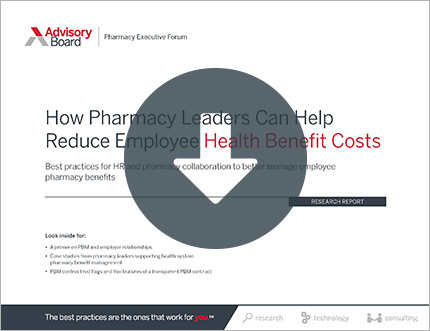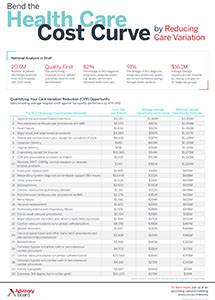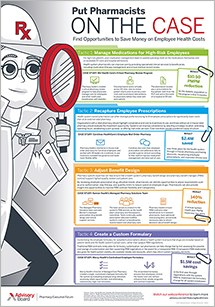Auto logout in seconds.
Continue LogoutThe total cost of health coverage for an employee is expected to reach nearly $15,000 in 2019, according to a National Business Group on Health (NBGH) survey released last week—and some employers are looking to curb those costs.
Infographic: How pharmacy can help reduce employee benefit costs
Survey details
NBGH conducted its Large Employers' 2019 Health Care Strategy and Plan Design Survey between May and June of this year. The survey includes responses from 170 large employers that represent various industries and offer health coverage to more than 19 million employees and their dependents.
Findings
According to the survey, the employers predicted that the cost of providing medical and pharmaceutical coverage to their employees will increase by 5% in 2019, marking the sixth consecutive year that such costs have increased by 5%. The survey found that, when accounting for both premiums and out-of-pocket costs for employees and their dependents, employers estimate the average cost of workers' coverage will reach $14,099 per employee in 2018 and will rise to an average of $14,800 in 2019.
Employers said they expect to cover about 70% of employees' medical and pharmaceutical coverage costs in 2019. Employees would be responsible for the remaining 30%, or nearly $4,500 per employee. Employers said costly medical claims, claims for specialty drugs, and certain health conditions are key drivers of cost growth.
The survey also found that most respondents said the pharmaceutical supply chain must change in order to curb growing health care costs. According to the survey:
- 50% of respondents said the pharmaceutical supply chain is too complex and inefficient, and needs to be overhauled and streamlined;
- 35% of respondents said rebates in the pharmaceutical supply chain should be reduced; and
- 14% of respondents said the pharmaceutical supply chain should be more transparent.
The survey found that 75% of respondents said they do not think drugmaker rebates are effective at bringing down drug costs, and 90% said they would be open to an alternative to the rebate system.
Employers look to curb rising costs
NBGH President and CEO Brian Marcotte said, "Health care cost increases continue to outpace workers' earnings and increases in inflation, making this trend unaffordable and unsustainable over the long term." As such, Marcotte said, "[A] growing number of employers are taking an activist role in shaking up how care is delivered and paid for."
For instance, the survey found that 49% of respondents said they are directly driving change in health care delivery or doing so via their health plan, using digital tools to curb health care costs, or both.
According to the survey, 35% of respondents said they are implementing alternative payment and delivery models, such as high performance networks and accountable care organizations, directly or via their health plans. The percentage of respondents who are directly contracting with health care providers and health systems is projected to increase from 3% this year to 11% in 2019, according to the survey. Further, the percentage of respondents expected to have direct contracts with centers of excellence for certain health care services is projected to increase from 12% this year to 18% next year, the survey found.
The survey also found that 52% of respondents said they think virtual care will be a significant part of how care is delivered in the future, and 51% said implementing additional virtual care solutions is their top health care initiative in 2019. According to the survey:
- 65% of respondents said they will offer virtual behavioral/mental health services in 2018;
- 58% said they will offer virtual health and lifestyle coaching in 2018; and
- 42% said they will offer virtual diabetes management services in 2018.
In addition, the survey found that 27% of respondents are implementing capabilities from pharmacy benefit managers to apply drugmaker rebates at the point-of-sale to benefit consumers, and an additional 31% are considering implementing point-of-sale rebates within the next few years.
The survey also found that, for the first time in four years, the percentage of employers that plan to offer only account-based Consumer Directed Health Plans (CDHPs) will decrease from 39% in 2018 to 30% in 2019. Marcotte said that change likely stems from the continued delay of the Affordable Care Act's (ACA) Cadillac tax. "The build-up of CDHPs has been driven primarily by the [ACA] and the Cadillac tax, which was looming to go into effect in 2018," Marcotte said, explaining, "You had a lot of companies rush to move to [high-deductible health plans] to either minimize the impact of the Cadillac tax or delay it as far as they could." But now, "[t]here's a view that [the Cadillac tax] may continue to be kicked down the road, so I think employers are relaxing their move (toward high-deductible plans) from that perspective," Marcotte said.
Marcotte also said many respondents noted the need for outside actors to help reform health care delivery.
For instance, Marcotte said, "If you begin to leverage Amazon's footprint within the home, their relationship with the consumer and their customer obsession, if you can incorporate health care into [employees'] routine and leverage [Amazon's] platform, then you have an opportunity to reach [employees] in a way nobody has been able to" (Otto, Employee Benefit News, 8/8; NBGH release, 8/7; Japsen, Forbes, 8/7; Livingston, Modern Healthcare, 8/7; Kuehner-Hebert, Benefits Pro, 8/7; Coombs, CNBC, 8/7).
Learn more: How pharmacy can help reduce employee benefit costs
Download this infographic to learn four pharmacy-led tactics to improve employee medication management and support HR leaders in reducing employee benefit costs.
Don't miss out on the latest Advisory Board insights
Create your free account to access 1 resource, including the latest research and webinars.
Want access without creating an account?
You have 1 free members-only resource remaining this month.
1 free members-only resources remaining
1 free members-only resources remaining
You've reached your limit of free insights
Become a member to access all of Advisory Board's resources, events, and experts
Never miss out on the latest innovative health care content tailored to you.
Benefits include:
You've reached your limit of free insights
Become a member to access all of Advisory Board's resources, events, and experts
Never miss out on the latest innovative health care content tailored to you.
Benefits include:
This content is available through your Curated Research partnership with Advisory Board. Click on ‘view this resource’ to read the full piece
Email ask@advisory.com to learn more
Click on ‘Become a Member’ to learn about the benefits of a Full-Access partnership with Advisory Board
Never miss out on the latest innovative health care content tailored to you.
Benefits Include:
This is for members only. Learn more.
Click on ‘Become a Member’ to learn about the benefits of a Full-Access partnership with Advisory Board
Never miss out on the latest innovative health care content tailored to you.



